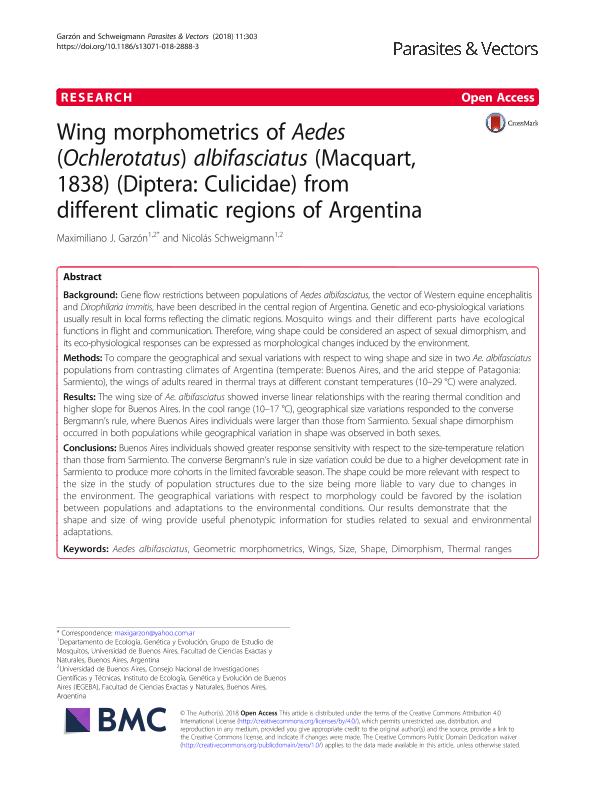Artículo
Wing morphometrics of Aedes (Ochlerotatus) albifasciatus (Macquart, 1838) (Diptera: Culicidae) from different climatic regions of Argentina
Fecha de publicación:
05/2018
Editorial:
BioMed Central
Revista:
Parasites and Vectors
ISSN:
1756-3305
Idioma:
Inglés
Tipo de recurso:
Artículo publicado
Clasificación temática:
Resumen
Background: Gene flow restrictions between populations of Aedes albifasciatus, the vector of Western equine encephalitis and Dirophilaria immitis, have been described in the central region of Argentina. Genetic and eco-physiological variations usually result in local forms reflecting the climatic regions. Mosquito wings and their different parts have ecological functions in flight and communication. Therefore, wing shape could be considered an aspect of sexual dimorphism, and its eco-physiological responses can be expressed as morphological changes induced by the environment. Methods: To compare the geographical and sexual variations with respect to wing shape and size in two Ae. albifasciatus populations from contrasting climates of Argentina (temperate: Buenos Aires, and the arid steppe of Patagonia: Sarmiento), the wings of adults reared in thermal trays at different constant temperatures (10-29 °C) were analyzed. Results: The wing size of Ae. albifasciatus showed inverse linear relationships with the rearing thermal condition and higher slope for Buenos Aires. In the cool range (10-17 °C), geographical size variations responded to the converse Bergmann's rule, where Buenos Aires individuals were larger than those from Sarmiento. Sexual shape dimorphism occurred in both populations while geographical variation in shape was observed in both sexes. Conclusions: Buenos Aires individuals showed greater response sensitivity with respect to the size-temperature relation than those from Sarmiento. The converse Bergmann's rule in size variation could be due to a higher development rate in Sarmiento to produce more cohorts in the limited favorable season. The shape could be more relevant with respect to the size in the study of population structures due to the size being more liable to vary due to changes in the environment. The geographical variations with respect to morphology could be favored by the isolation between populations and adaptations to the environmental conditions. Our results demonstrate that the shape and size of wing provide useful phenotypic information for studies related to sexual and environmental adaptations.
Archivos asociados
Licencia
Identificadores
Colecciones
Articulos(IEGEBA)
Articulos de INSTITUTO DE ECOLOGIA, GENETICA Y EVOLUCION DE BS. AS
Articulos de INSTITUTO DE ECOLOGIA, GENETICA Y EVOLUCION DE BS. AS
Citación
Garzón, Maximiliano Javier; Schweigmann, Nicolas Joaquin; Wing morphometrics of Aedes (Ochlerotatus) albifasciatus (Macquart, 1838) (Diptera: Culicidae) from different climatic regions of Argentina; BioMed Central; Parasites and Vectors; 11; 1; 5-2018; 1-10
Compartir
Altmétricas




